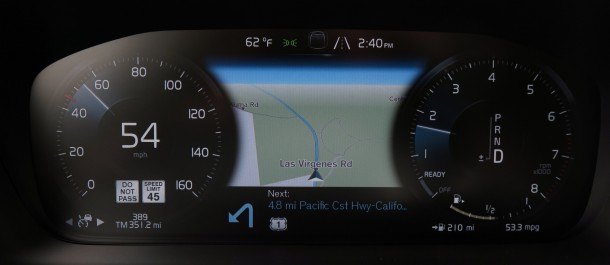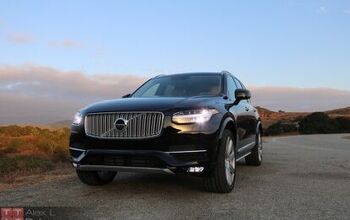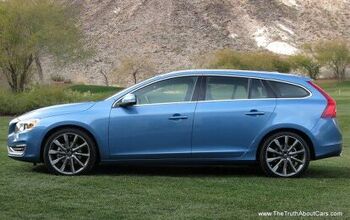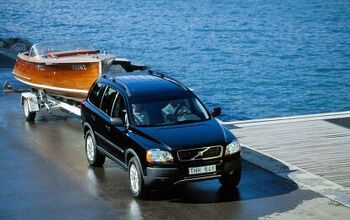2016 Volvo XC90 First Drive (With Video)

Volvo seems to be on the long road to recovery. Although sales have continued to slip in the USA, the numbers were up worldwide last year. In an interesting twist, 2014 was also the first year more Volvos were sold in China than North America. That could be cause-and-effect since Volvo had been more focused on their European-only new compact sedan and wagon. 2016 finally showers some Swedish love on America with a complete redesign of the XC90, the SUV originally designed for us. Because China is now a bigger market than we are, this XC90 isn’t just for us, but for China and the growing number of big crossovers clogging up Europe as well.
Exterior
Up front is a bolder, flatter grille (thanks to pedestrian impact regulations), distinctive optional LED headlamps and a shorter front overhang than ever before. The shorter overhang is possible because this is the first Volvo in ages designed to accept only 4-cylinder or smaller engines under the hood. Out back, the distinctive Swedish hips are nearly gone, replaced by a more sloping profile that is more aggressive but less extraordinary. The Audi influence is most apparent out back where U.S.-bound models get red turn signals instead of the amber blinkers found on the European model. While Audi supposedly makes the amber-to-red change because the amber lamps from the EU don’t cover enough surface area, Volvo’s switch is purely aesthetic.
Interior
The new SUV gets Volvo’s first complete seat redesign in ages. The Swedish thrones have long had a reputation for impressive ergonomics, but a refresh was overdue. The new design allows for 4-way lumbar, adjusting side bolsters, extending thigh cushions and ventilation in addition to heating. I was unable to sample the less capable base seat, but 8 hours in the top-end model confirms Volvo has improved the adjustability without sacrificing their legendary comfort and support.
Hop in the back and you’ll notice the XC90’s length may have grown over time, but interior height is actually down in some measures. This makes the third row very unusual. The seats are some of the most comfortable mother-in-law-row seats I’ve had the pleasure to sit in, but the headroom limits their usefulness to those under 5’8. The cargo area is surprisingly generous behind the third row with enough room to stuff roller bags in the long way, but I suspect most folks will keep the way-back seats folded. If that describes your typical third row usage, you may want to lobby Volvo for the seating accoutrements in the picture below.
As we’ve all heard, chauffeurs are cheap in China and being driven is preferred to driving. To satisfy this growing segment of Chinese society, Volvo will build the XC90 Excellence, which can be had as either a 3 or 4 seat model. No, Volvo didn’t bring one to sample to the event, but I mention it because the concept sounded way out in left field when I first saw the blog posts about it a few weeks ago. After having experienced the new interior, however, I have to say it makes sense. All but the steering wheel airbag cover is Range Rover competitive and I wouldn’t mind seeing a 5-seat variant with a little extra “plush” in the back. Just call it something other than the “XC90 Excellence.” Please.
Infotainment
Over on the driver’s side is an all-new and all-gigantic 12.3-inch LCD instrument cluster. The gauge design is elegant and well-laid out using nearly 1/3 of the display for either your media functions or a navigation map, even when a destination is not set. I’d say the new Volvo display ranks on par with the new Mercedes S-Class and ahead of the Jaguars and Land Rovers with disco dashes in terms of design. Speaking of JLR products, I have one gripe: like the English disco dashes, Volvo has little ability to customize the LCD aside from colors and some minor gauge changes. Although GM has only four different layouts to chose from in Cadillac CUE, that’s three more than Volvo and the looks are all different.
Safety
Safety seems to be a game of diminishing returns, so the new systems focus on higher hanging fruit. The run-off-road protection uses the City Safety camera to determine if you are leaving the road surface. If you do, new seatbelt tensioners will pull you into place and a deforming seat frame makes sure when you launch into the air and land, spinal forces are reduced by 1/3. There’s also a rear-end collision warning that lets you know a drunk is about to plow into your hind end. The system will tension the seat belts, flash the hazard lights to attract the attention of the other driver, and will use the brakes to keep the car under control during and after the collision.
Drivetrain
Volvo’s hybrid system is thematically similar to Acura’s RLX hybrid. Things start with the same 316 hp engine and 8-speed auto as the T6, but they jam a 46 hp, 103 lb-ft electric starter/motor/generator between the engine and torque converter. The engineers ditched the Haldex AWD so they could stuff a water-cooled 9.3 kWh lithium ion battery in the tunnel between the front seats. The mechanical AWD is replaced by a 87 hp, 177 lb-ft electric motor connected to the rear axle sending power through a fixed 10:1 reduction gear. With a maximum discharge rate of 87 hp from the battery, the power and torque curves combine to give the driver 400 ponies and 475 lb-ft of torque. (Official US numbers are not final.) If you live in the snow belt, you should know while the T6 can send 158 hp to the rear on a whim, 87 is the most you’ll ever get in the T8. If that sounds like the Lexus and Acura eAWD systems, you’re right, so expect similar snow and ice performance.
Drive
This puts the XC90 closer to the X5 than the MDX or QX60 in terms of grip. Configured comparably, the X5 will out handle the XC90 thanks to a RWD dynamic and better weight balance. But, the XC90 is less expensive. So, configured to a similar price, the Volvo will likely win. Speaking of price, the XC90 and the MDX price out almost identically. Although the XC90 starts higher at $48,900, it comes with standard AWD and the Acura doesn’t. Similarly configured an MDX Advance and a XC90 Momentum (with appropriate options) end up just $100 apart, a decent discount vs the other Euro options.
The all-new XC90 features a completely new chassis, front and rear, including a double wishbone front suspension.
The engineers are claiming a 6.1 second 0-60 time – the same time advertised by BMW for the X5 in both RWD and AWD forms. Unfortunately, I was unable to 0-60 test the Volvo. Going back in our logs, I discovered that the 2015 X5 xDrive35i is the only BMW in recent memory to take longer to get to 60 than BMW’s claimed. The X5 hit 60 after 6.5 seconds, meaning the Volvo may be a hair faster. Check back for full specs when we get our hands on one for a full review. Add the hybrid hardware and Volvo says 0-60 drops to 5.7 seconds – notably faster than the QX60 hybrid (7.1) but a far cry from the 4.4L turbo X5 (4.7).
Numbers aside, the small engine in the XC90 certainly has a different feel than the 3.0L engine in the BMW. Low end torque from idle lags then comes on strong. Passing torque is excellent at most speeds, and at high RPMs the engine feels a hair more out of breath than the larger displacement options.
The XC90 isn’t a game changer for Volvo in America. It can’t be. A brand is more than one car. However, if the XC90 is a window into Volvo’s future, then I have high hopes. If the Swedes can make over their entire lineup fast enough, they may also salvage their American sales numbers. This kind of interior quality in a 3-series sized vehicle would give even the all-new and all-tasty C-Class a run for its money. Just two things stand in their way: a distinct lack of marketing to let Audi shoppers know there is a better crossover for sale and the worrying thought it may be another 12 years until this XC90 gets redesigned. If you’re shopping for a luxury 3-row and don’t give the XC90 a look, you’re missing out on one tasty meatball.
Volvo provided the vehicle at a lunch event.

More by Alex L. Dykes
Latest Car Reviews
Read moreLatest Product Reviews
Read moreRecent Comments
- Peter Buying an EV from Toyota is like buying a Bible from Donald Trump. Don’t be surprised if some very important parts are left out.
- Sheila I have a 2016 Kia Sorento that just threw a rod out of the engine case. Filed a claim for new engine and was denied…..due to a loop hole that was included in the Class Action Engine Settlement so Hyundai and Kia would be able to deny a large percentage of cars with prematurely failed engines. It’s called the KSDS Improvement Campaign. Ever hear of such a thing? It’s not even a Recall, although they know these engines are very dangerous. As unknowing consumers load themselves and kids in them everyday. Are their any new Class Action Lawsuits that anyone knows of?
- Alan Well, it will take 30 years to fix Nissan up after the Renault Alliance reduced Nissan to a paltry mess.I think Nissan will eventually improve.
- Alan This will be overpriced for what it offers.I think the "Western" auto manufacturers rip off the consumer with the Thai and Chinese made vehicles.A Chinese made Model 3 in Australia is over $70k AUD(for 1995 $45k USD) which is far more expensive than a similar Chinesium EV of equal or better quality and loaded with goodies.Chinese pickups are $20k to $30k cheaper than Thai built pickups from Ford and the Japanese brands. Who's ripping who off?
- Alan Years ago Jack Baruth held a "competition" for a piece from the B&B on the oddest pickup story (or something like that). I think 5 people were awarded the prizes.I never received mine, something about being in Australia. If TTAC is global how do you offer prizes to those overseas or are we omitted on the sly from competing?In the end I lost significant respect for Baruth.
























































Comments
Join the conversation
This will be an interesting test case where the "bigger" engine option has more FWD-bias than the "smaller" one.
Putting a deposit down on one this week. I am getting it loaded white with the dark tan. I am coming from a 2012 BMW X5 with the 5.0 v8 and M-Sport package that is fun but fatiguing to drive. This will be my commuter car. I have been shopping the MDX and Q7 for a long while. No more BMWs and the Infiniti is just plain ugly. I was incredibly impressed with this during my test drive. Even my wife who rolls her eyes at my vehicular ADD was impressed. When I told her I was going to put a deposit down she said good call. The interior is spectacular. Would like some other options on the dash TFT display. The infotainment is lightening fast very intuitive. The B&W audio system sounded fantastic. Performance was good to very good given my expectations were mentally managed given the car I am coming from. I am just glad I won't be spending 2500 bucks every 20k miles or so on tires and dodging potholes in Denver like I am dodging land mines. Now I just have to wait four months to get one. Dang it.